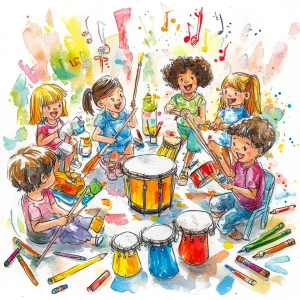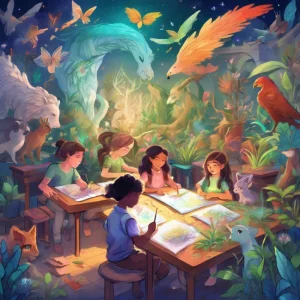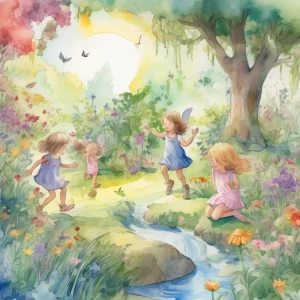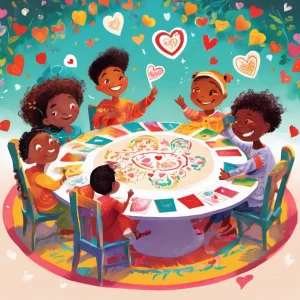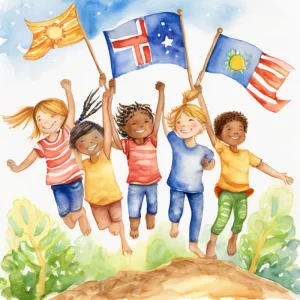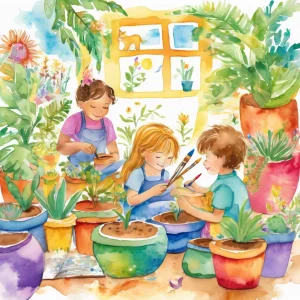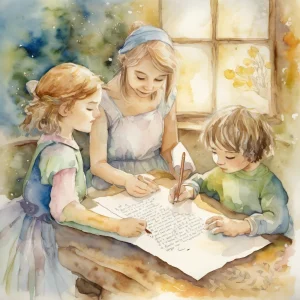Activity
Similar Activities
Empathy Tales: Digital Story Clay Creations
Children’s Age: 3–18 years
Activity Duration: 10 – 25 minutes
In this activity, children aged 3 to 18 years old can explore empathy and creativity through a mix of digital storytelling and clay sculpting. You'll need a tablet or computer, cla…
Activity Duration: 10 – 25 minutes
Empathy Through Storytelling: Musical Sensory Experience
Children’s Age: 2–3 years
Activity Duration: 5 – 15 minutes
Let's dive into Musical Sensory Storytime! Get ready for a fun experience that will engage all your senses. We will read a story, play musical instruments, create art, and enjoy co…
Activity Duration: 5 – 15 minutes
Whispers of the Cultural Garden Storytelling Forest
Children’s Age: 10–12 years
Activity Duration: 40 – 45 minutes
Engage children in the "Cultural Garden Storytelling" activity for a creative experience supporting empathy and language skills. Set up a cozy area with cushions, books, plants, an…
Activity Duration: 40 – 45 minutes
Enchanted Forest: Animal Hunt Adventure Discovery
Children’s Age: 5–7 years
Activity Duration: 15 – 25 minutes
"Animal Hunt Adventure" is an engaging outdoor activity that promotes cognitive development, self-care, and communication skills for children aged 5 to 7. With printed animal pictu…
Activity Duration: 15 – 25 minutes
Creating Empathy Cards Through Art for Kids
Children’s Age: 3–6 years
Activity Duration: 5 – 20 minutes
In the Empathy Building Art Project, children aged 3 to 6 get to be creative while learning about empathy. You will need paper, crayons, markers, stickers, glue, and scissors. Set …
Activity Duration: 5 – 20 minutes
Cosmic Harmonies: Music from Space Journey
Children’s Age: 10–12 years
Activity Duration: 40 minutes
"Music from Space" is an engaging activity tailored for children aged 10-12, combining fun and education to promote academic growth, empathy, and ecological awareness. Participants…
Activity Duration: 40 minutes
Empathy Through Art: Digital Diversity Collage Journeys
Children’s Age: 2–2.5 years
Activity Duration: 10 minutes
The "Digital Diversity Collage" activity is designed to foster empathy, adaptive skills, and cultural awareness in children aged 24 to 30 months using art and creativity. You will …
Activity Duration: 10 minutes
Enchanted Seasons: Seasonal Nature Hunt
Children’s Age: 6–10 years
Activity Duration: 25 – 30 minutes
"Seasonal Nature Hunt" is a delightful activity designed for children aged 6 to 10, focusing on cognitive development, nature appreciation, and logical reasoning. Kids can explore …
Activity Duration: 25 – 30 minutes
Empathy Journey: Cultural Balance Relay Race Adventure
Children’s Age: 6–9 years
Activity Duration: 25 – 30 minutes
The Cultural Balance Relay Race activity encourages empathy, teamwork, and cultural understanding in children. Set up the course with flags, cones, ecosystem visuals, and music for…
Activity Duration: 25 – 30 minutes
Cultural Creatures: Stop-Motion Animation Adventure
Children’s Age: 4–9 years
Activity Duration: 10 – 25 minutes
An interactive activity using technology to create stop-motion animations exploring plants and animals from diverse cultures.
Activity Duration: 10 – 25 minutes
Animal-Inspired Plant Pots: Creative Nature Creations
Children’s Age: 3–6 years
Activity Duration: 20 minutes
Children will have a blast making animal-inspired plant pots, sparking creativity while learning about nature. Gather supplies like paint, pots, seeds, and soil to set up a creativ…
Activity Duration: 20 minutes
Gratitude Journey: Writing Thank-You Notes Experiment
Children’s Age: 6–8 years
Activity Duration: 10 – 20 minutes
A creative activity for children aged 7-8 to write thank-you notes, enhancing cognitive and communication skills.
Activity Duration: 10 – 20 minutes





